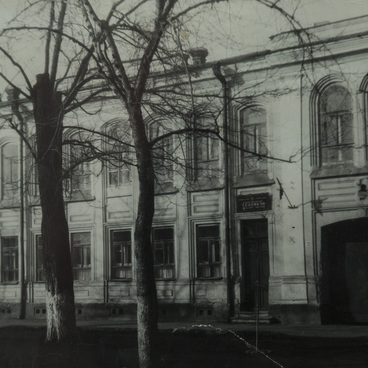The photographs presented in the exhibit show the initiators of the relocation of Ossetian highlanders to Karachay-Cherkessia. Among them were an officer of the tsarist army, Second Lieutenant Levan Khetagurov (second from the left in this photo) and his friend, an ensign of the Terek Region militia of the Tagaur-Kurtatinsky district Misirbi Gutiev (second to the right in this photo).
After the end of the Caucasian war, the mountain Ossetians, who suffered from landlessness, decided to move to the territory of the modern Karachay-Cherkess Republic, where at that time there were many uninhabited lands, led by Levan Khetagurov, father of the poet Kosta Khetagurov.
He persuaded his countrymen to move to those parts, and 150 families — 864 people — went on a journey that lasted for one and a half months. The path taken by the Ossetians took them through the lands of other peoples. The settlers were greeted with friendly greetings by Circassians, Karachays, and Russians. One of the famous princes of the Loovs presented them with several heads of cattle for a feast in honor of their stay on the Abazin land.
Having reached their destination in 1870, the Ossetians settled on the left bank of the Kuban River in the vicinity of a medieval Shoininski temple. At first, the settlers had to live in dugout houses, as the promised tsarist relocation allowances, which could be used to build good houses, were to be received only in two years' time.
Konstantin Barakov became the elder of the settlement. He organized the village in the Cossack style, with straight streets that intersected in the center, where the main square was located. Each hectare of land was divided between four families, and the residents began to engage in farming and animal husbandry. Within five years, the village was thriving. And the roofs of some of the houses were soon sparkled with copper, which in those days was considered a sign of prosperity.
At first, the village was officially called Shoaninskoe, named after the nearby mountain of Shoana. In 1879, it was renamed to Georgiyevsko-Osetinskoye. This name remained until 1939, when the village was renamed after the poet Kosta Khetagurov, who spent his final days there.
After the end of the Caucasian war, the mountain Ossetians, who suffered from landlessness, decided to move to the territory of the modern Karachay-Cherkess Republic, where at that time there were many uninhabited lands, led by Levan Khetagurov, father of the poet Kosta Khetagurov.
He persuaded his countrymen to move to those parts, and 150 families — 864 people — went on a journey that lasted for one and a half months. The path taken by the Ossetians took them through the lands of other peoples. The settlers were greeted with friendly greetings by Circassians, Karachays, and Russians. One of the famous princes of the Loovs presented them with several heads of cattle for a feast in honor of their stay on the Abazin land.
Having reached their destination in 1870, the Ossetians settled on the left bank of the Kuban River in the vicinity of a medieval Shoininski temple. At first, the settlers had to live in dugout houses, as the promised tsarist relocation allowances, which could be used to build good houses, were to be received only in two years' time.
Konstantin Barakov became the elder of the settlement. He organized the village in the Cossack style, with straight streets that intersected in the center, where the main square was located. Each hectare of land was divided between four families, and the residents began to engage in farming and animal husbandry. Within five years, the village was thriving. And the roofs of some of the houses were soon sparkled with copper, which in those days was considered a sign of prosperity.
At first, the village was officially called Shoaninskoe, named after the nearby mountain of Shoana. In 1879, it was renamed to Georgiyevsko-Osetinskoye. This name remained until 1939, when the village was renamed after the poet Kosta Khetagurov, who spent his final days there.



